Elemental characteristics of lacustrine oil shale and its controlling factors of palaeo-sedimentary environment on oil yield:a case from Chang 7 oil layer of Triassic Yanchang Formation in southern Ordos Basin
2018-06-27DeluLiRongxiLiZengwuZhuFengXu
Delu Li•Rongxi Li•Zengwu Zhu•Feng Xu
1 Introduction
Regarded as one of the importantun conventional resources,oil shale is a solid organic sedimentary rock(Liu et al.2015).After being combusted by low-temperature carbonization,it can produce shale oil(Liu et al.2009).The ratio of shale oil to oil shale in unit mass is oil yield.In petroleum reserve assessments,oil yield,as a key evaluation index,has a direct influence on evaluation results(Li et al.2014).Therefore,the research on controlling factors of oil yield becomes more and more significant,especially in the lack of conventional resources nowadays.
There are many factors affecting oil yield of lacustrine oil shale,primarily including:the foundation of hydrocarbon generation(Fahmi et al.2008),the control action of palaeosedimentary environment(Han et al.2014),later preservation condition(Brumsack 1988;Dean and Arthur 1989),etc.And the degree of effect of different factors are also various.Considering that many factors are hardly quantified,the study on controlling factors of oil yield is still in a qualitative stage(Chang et al.2012).However,with the development of elemental geochemistry,the abundant palaeosedimentary environment can be well expressed by some parameters,which can help researchers explore their correlations more accurately(Chermak and Schreiber 2014;Mapoma et al.2014).
With superior oil yield,oil shale from Triassic Yanchang Formation in Ordos Basin has the typical lacustrine characteristics in China.Previous studies mainly concentrate on organic geochemistry and sedimentary facies(Jiang et al.2013;Yuan et al.2015),and the research on inorganic geochemistry,especially elemental geochemistry,are seldom seen before,leading to incomplete recognition.In addition,the relationships between oil yield and palaeosedimentary environment are still uncertain.So,it is vital to make an investigation on elemental geochemistry so as to further make palaeosedimentary environment clear on one hand,and to find out main controlling factors of palaeosedimentary environment on oil yield on the other hand.
In this paper,the characteristics of oil yield and palaeosedimentary environment,including paleo-redox condition,paleosalinity,paleoclimate,hydrothermal depositional condition,paleo-hydrodynamics,and paleo-waterdepth are discussed.Then,main controlling factors of palaeosedimentary environment on oil yield are found using statistical methods.This contribution fills in gaps of study on main controlling factors of oil yield in lacustrine oil shale and has significance in guiding future exploration.
2 Geological settings
Located in central China,Ordos Basin is a Mesozoic depressed basin on a Paleozoic Craton with a Proterozoic crystalline basement(Wan et al.2013;Li et al.2013)(Fig.1a).According to tectonic characteristics,the basin is classified to six first order tectonic units,Yimeng Uplift,Yishan Slope,Weibei Uplift,Tianhuan Depression,Western Thrusted Zone,and Jinxi Flexure Zone.By Permian-Carboniferous,Ordos Basin belonged to the marine basin of North China Block.After Middle Triassic,the initial appearance of basin gradually formed.During Indosinian Orogeny,the whole basin was in stable condition mostly.In Upper Triassic and Early-Middle Jurassic,the basin entered a period of prosperous development.Then,the basin gradually uplifted and subducted in Early Cretaceous and Weibei Uplift deposited mainly in receiving sediments.After that,tectonic orogenies developed variably and Ordos Basin underwent reformation(Li et al.2011,2013;Yang et al.2016;Qiu et al.2014,2015).Since the Eocene epoch,the lifting of Weibei Uplift gradually increased until now(Fig.2)(Wang et al.2010).The Triassic Upper Yanchang Formation from the southern basin is dominated by the fluvial-lacustrine depositional system with a thickness of 1000–1300 m(Qiuetal.2015)and divided into 10oil layers(Chang 10-Chang 1 from the bottom to the top in order)according to the sedimentary cycle.The whole formation represents an integrated lacustrine transgressive-lacustrine regressive cycle and early Chang 7 oil layer is regarded as the most developmental period of the lake(He 2003).Previous studies indicated that Chang 7 oil layer in the north of Weibei Uplift deposited in semi deep–deep lake facies(Yang et al.2016)and the lithologies at the bottom are mainly oil shale and silty mudstone with a deep lake environment(Fig.1b).Modified after Qiu et al.(2014).
3 Samples and analysis methods
Attaching to Weibei Uplift,the studied area is located in southern Ordos Basin(Fig.1a).A total of 25 oil shale samples from four drillings were collected(Fig.3).
For oil yield of oil shale analysis,samples are ground till particle size is under 3 mm,then 50 g of them is enclosed into aluminum retort with low-temperature carbonization method.The procedures follow the Chinese standard methods SH/T 0508-1992.The analytical error is within 5%.The experiment is conducted at Shaanxi Coal Geological Laboratory Co.,Ltd.
The samples for element analysis were all crushed and ground to less than 200 mesh,using X-ray fluorescence spectrometry(XRF)and inductively-coupled plasma mass spectrometer with AA-6800at omicabsorption spectroscopy,UV-2600 ultraviolet–visible spectrophotometer and Perkin Elmer SciexElan 6000.The analytical procedures follow Chinese National Standard GB/T14506.1~14-2010 and GB/T14506.30-2010.The analytical uncertainty is within 5%.The analyses are at Analytical Center,No.203 Research Institute of Nuclear Industry.
4 Results
4.1 Oil shale and its oil yield characteristics
Oil shale from Chang 7 oil layer in the study area is characterized by black and brown color and lamina shape with greasy luster and jagged fracture.The oil shale thickness is generally over 10 meters with fossils of fish scale and plant stems.The oil yields of 21 oil shale samples from Chang 7 oil layer range from 1.40%to 9.10%with an average of5.01% (Table 1).According to National resource assessment(Zhao et al.1991),the oil shale quality is classified to middle-grade criterion.
4.2 Major element geochemistry

Fig.1 The tectonic map of Ordos Basin and stratigraphic column of the Upper Triassic Yanchang Formation.a The tectonic map of Ordos Basin and location of studied section,b stratigraphic column of Upper Triassic Yanchang formation
Major oxides data show that SiO2content ranks the most abundant content(36.42%–64.70%)in all oxides.Al2O3(10.69%–20.15%),TFe2O3(total iron)(3.61%–11.27%)and K2O(1.49%–4.11%)are the second most abundant oxides.The rest of the oxides(MgO,Na2O,P2O5,MnO,and TiO2)have a concentration of less than 4%.SiO2mainly occurs in quartz and clay minerals(Fu et al.2010a,b).The Al/Si ratio of shale samples is from 0.25 to 0.42(Table 1),indicating that SiO2is primarily related with quartz.The correlation coefficient(r=0.47)between SiO2and Al2O3further support the recognition.The element Al is usually from clay minerals(Fu et al.2010a,b)and the relatively high content of Al2O3manifest that clay minerals commonly occurs in oil shale samples(Fig.4a).MgO concentration holds a positive correlation(r=0.72)with Al2O3,implying Mg is also from clay minerals.Generally,a high concentration of CaO is related with abundant bivalve and gastropod fossil remains and low concentration may refer to fossil remains in oil shale(Mukhopadhyay et al.1998;Fu et al.2010a,b).The content of CaO is relatively low(0.39%–3.59%),elucidating that Ca possibly exists in organic matter partially.The fossils of fish scale in oil shale bedding can also demonstrate this.A mass of framboids of pyrite in oil shale samples in SEM analyses can support that Fe is mainly associated with pyrite(Fig.4b).
4.3 Trace element geochemistry
Table 2 shows the results of trace elements of 21 oil shale samples from Chang 7 oil layer.The relatively high average concentrations of trace elements in oil shale samplesare Ba (622.35 μg/g),Sr(241.70 μg/g),V(192.87 μg/g),Zr(145.69 μg/g),Rb(120.93 μg/g),and Zn(101.79 μg/g),whereas all the other elements occur in amounts smaller than 100 μg/g.Enrichment factor(EF)is always calculated to evaluate the element enrichment degree(Patterson et al.1986),which was defined as the ratio of the concentration of an element in samples to the corresponding value of Upper Continental Crust(UCC)(Rudnick and Gao 2003).As seen from Table 3 and Fig.5,trace elements can be classified into three types,according to enrichment state.(1)Extremely concentrated type(average EF>5):As,U,Cd,and Mo.(2)Concentrated type(1<average EF<5):V,Cu,Zn,Ga,Pb,Rb,Cs,Th,Nb,Hf,Ta,Li,Be,In,Bi,and B.(3)Depleted type(average EF<1):Cr,Sr,Zr,Ba,Sc,Co,and Ni.As a whole,oil shale from Chang 7 oil layer is characterized by enrichment of metallic elements.
Usually,Cu concerns biological growth and Mo is chalcophile elements(Sun et al.2015).Their concentrations in oil shale samples represent the prosperity of living substance during sedimentation.Element U shows+6 valence under the oxidizing condition and can hardly enrich,while in reducing environment,U shows+4 valence,leading to enrichment(Fan et al.2012).The extreme concentration of U suggests that oil shale may deposit in reducing environment.Element Ba is more prone to subside after entering the lake(Sun et al.1997),so its content gradually decreases along with the increase of distance from the lakeshore.The average EF of Ba shows a little deficit,indicating that oil shale deposit away from the lakeshore and more in depocenter.In addition,the content of Sr has a close relationship with Ca because of adsorption from biogenic shells.The average EF of Sr is a deficit,which is in accordance with low CaO concentration.
5 Discussions
5.1 Paleo-environment analysis
5.1.1 Paleo-redox condition
Paleo-redox condition plays an important role in the preservation of organic matter.Some redox-sensitive trace elements can reconstruct it well.In this study,in view of elements sensibility, V/Cr, V/(V+Ni), U/Th,δU[δU=2U/(U+Th/3)],and AU(AU=U-Th/3)are applied to judge redox condition comprehensively.
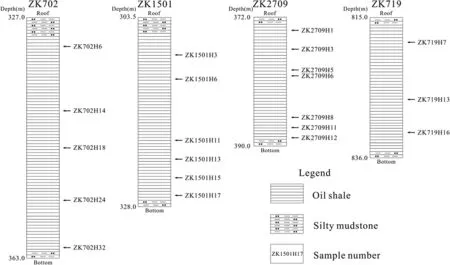
Fig.3 Oil shale drill sections from the bottom of Chang 7 oil layer,showing sampling locations
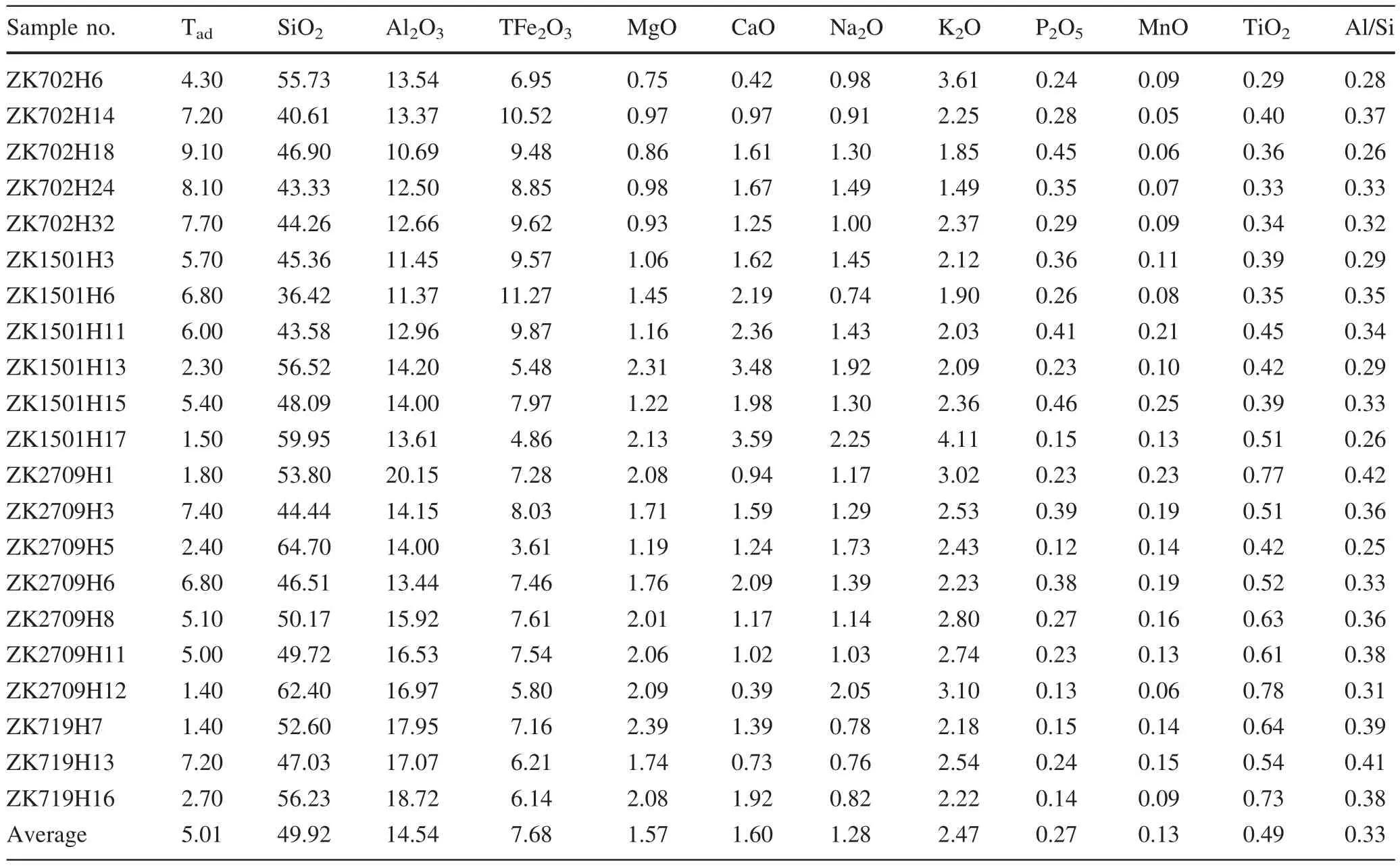
Table 1 Concentrations of oil yield,major elements and parameter of samples from Chang 7 oil layer(units in%)
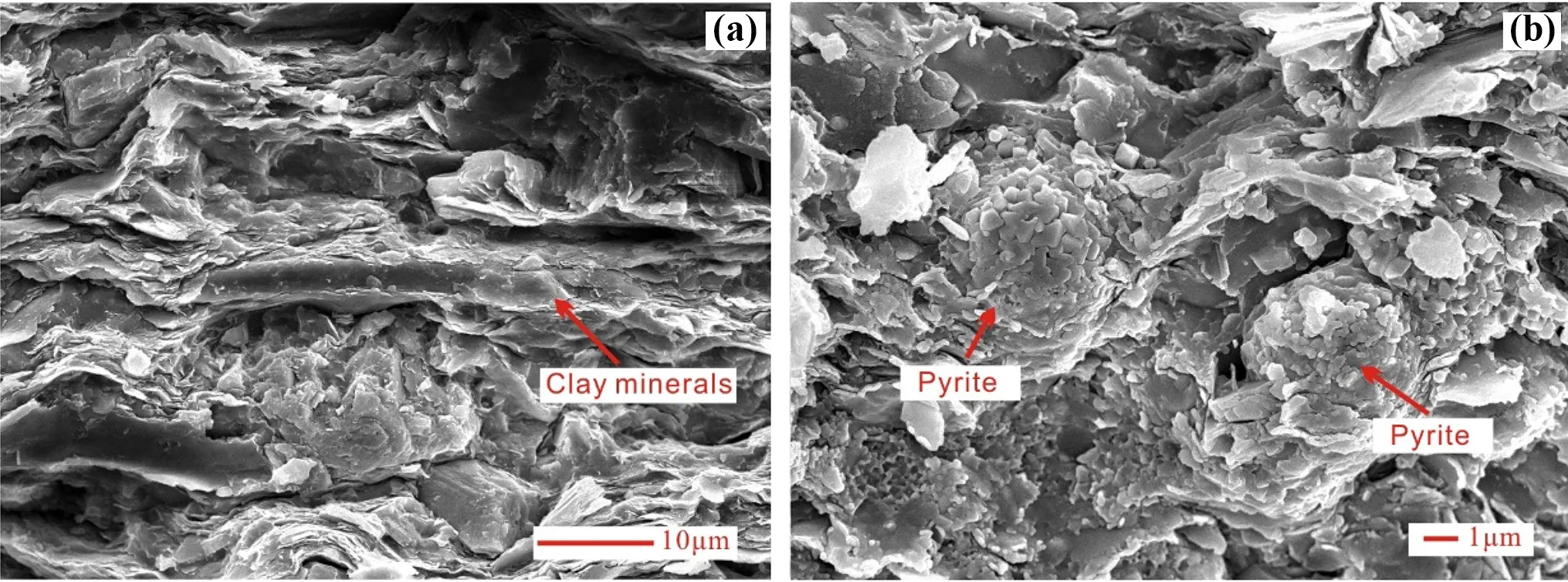
Fig.4 a Clay minerals of oil shale sample(ZK702)and b framboids of pyrite of oil shale sample(ZK2709)in SEM
Generally,V/Cr>4.25 indicates a strong reducing condition,and V/Cr with 2–4.25 shows reducing condition,and V/Cr<2.00 implies oxidation environment(Teng et al.2004).V/(V+Ni)>0.5 shows reducing condition.On the contrary,it shows oxidation condition(Tribovillard et al.2006).U/Th>1.25 elucidates strong reducing condition and U/Th in 0.75–1.25 represents the reducing condition,while U/Th<0.75 means oxidation condition(Ernst 1970;Jones and Manning 1994).δU<1 suggests strong reducing environment,and δU > 1 implies oxidation condition(Zhao et al.2016).AU>12 ppm means a strong reducing condition,and when it is below 5 ppm,it means oxidation condition(Teng et al.2005;Deng and Qian 1993).
All kinds of parameters showing paleo-environment are all listed in Table 4.The averages of V/Cr,V/(V+Ni),U/Th,δU and AU in oil shale samples are 2.90,0.85,1.50,2.24,and 24.21(Table 4).All parameters of oil shale samples show reducing-strong reducing environment during sedimentation.As can be seen from Table 4,the parameters of oil shale samples from ZK2709 and ZK719 are lower than the parameters from ZK702 and ZK1501 in varying degrees,implying the paleo-redox condition in the eastern area is more reducing than in the western area(Table 5).
5.1.2 Paleosalinity
Boron is a diffluent element,being in sedimentary rocks of hydrosphere or upper crust and it can be easily adsorbed by clay minerals.Once fixed in clay minerals,boron can hardly redissolve when the solubility of boron decreases(Zheng et al.2016).Therefore,the content of boron can be used to analyze paleosalinity(Xiao et al.1999;Lendergren and Carvajal 1969).Walker(1963)calculated Equivalent Boron through the content of boron and K2O to judge paleosalinity. The formula is Equivalent Boron=11.8×(B×8.5/K2O%)/[1.70×(11.8-K2O%)].B represents the content of boron.Degens et al.(1958)and Keith and Bystrom(1959)proposed the scope of sea water and fresh water by Equivalent Boron.When Equivalent Boron is in the range of 300–400,200–300 and<200 ppm,it means sea water,brackish water,and fresh water deposit.As calculated in Table 4,the content of Equivalent Boron in oil shale samples is from 39.90 to 234.70 with an average of 100.89,indicating that the sedimentary water is mainly fresh water.Adams et al.(1965)put forward to an equation to calculate paleosalinity.The equation is Sp=0.0977x-7.043.Sp represents paleosalinity(‰)and x represents Equivalent Boron.Previous study classified water by paleosalinity(Qin 2005),however,in order to unify standard of above salinity,we reconsider the classification and regard <5‰,5–18‰,and >18‰ as fresh water,brackish water,and sea water.The result of Sp is 0.21‰–15.89‰ (average 6.21‰),showing the character of fresh water and brackish water sedimentation(Table 5).
Sr/Ba ratio can also be used to reconstruct paleosalinity.After counting Sr/Ba of samples in 13 sea floors,Sr/Ba from 0.8 to 1.0 is regarded as marine deposit and below 0.6 is regarded as a lacustrine deposit(Wang and Wu 1983).Thus,Sr/Ba ratio with>1,0.6–1,and<0.6 are treated as sea water,brackish water,and fresh water.The Sr/Ba in oil shale samples from Chang 7 oil layer is in the range of 0.23–0.69(average 0.38),suggesting mainly fresh water deposition(Table 5).In summary,the paleosalinity of water during oil shale sedimentation could be mainly fresh water and brackish water.
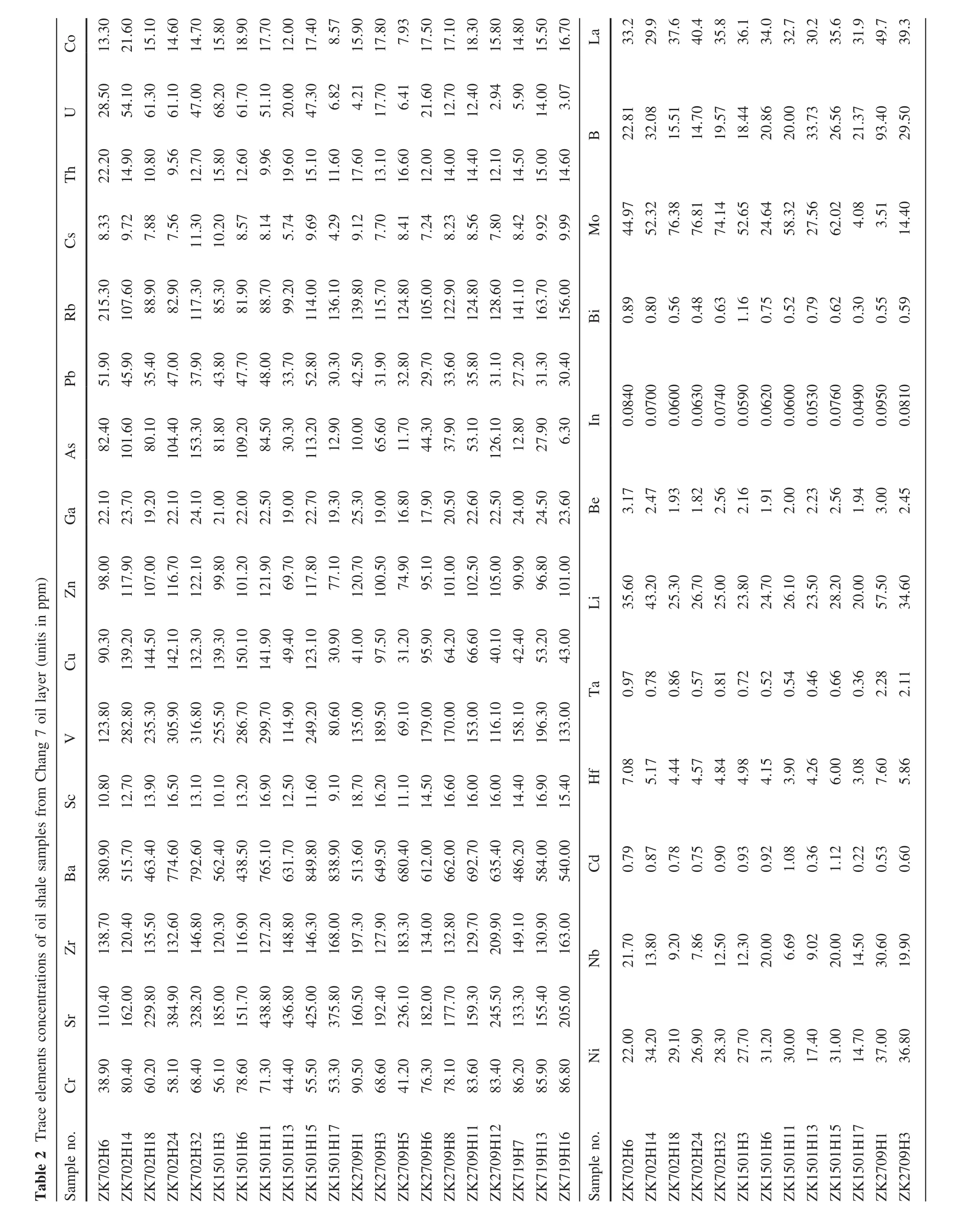
?
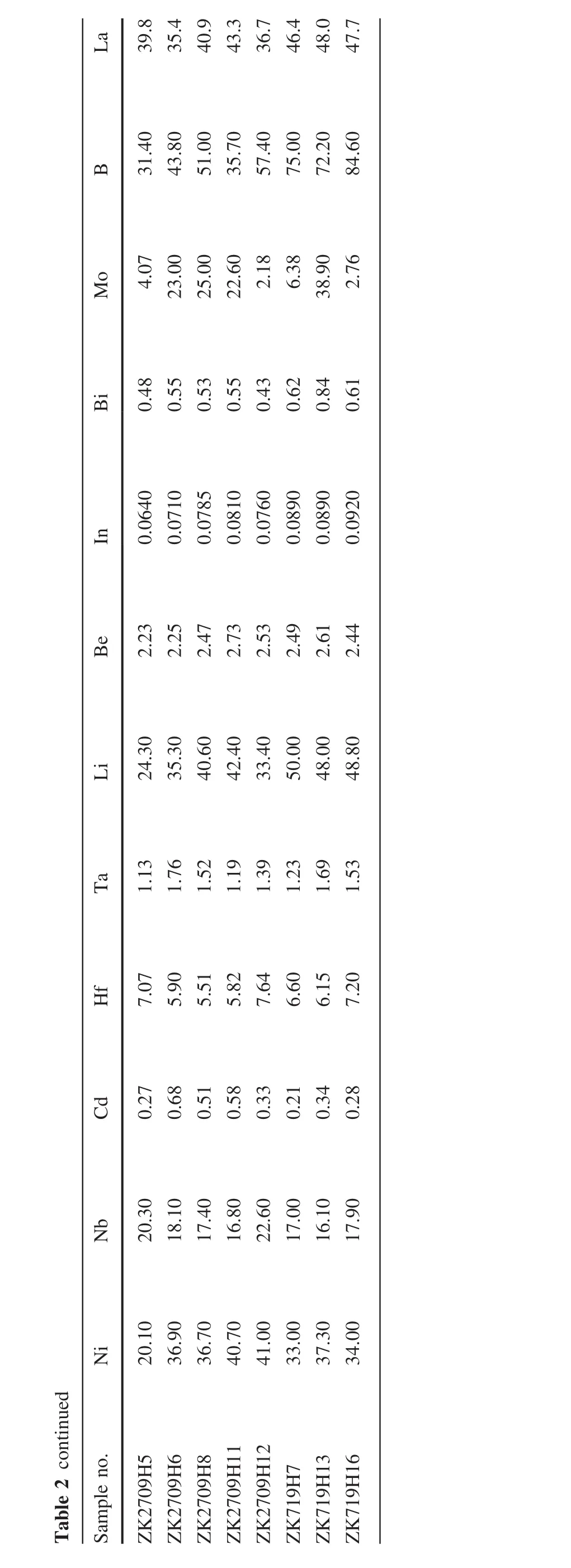
?
5.1.3 Paleoclimate
Paleoclimate can usually affect weathering,transportation,and composition of source rocks(Zhang et al.2011).The chemical index of alteration(CIA)can reflect the paleoclimatic conditions and has gained favorable application effect(Baietal.2015).The CIA expression is CIA=100×[Al2O3/(Al2O3+CaO*+Na2O+K2O)].CaO*refers to CaO in silicate and is calculated using the expression CaO*=CaO-(10/3×P2O5)to amend the content of apatite(Cox et al.1995).The CaO*result is chosen as the minimum between calculated result and the content of Na2O(Nesbitt and Young 1982).All oxide concentrations are given in molecular proportions.When the value of CIA is 50–65,it reflects cold and dry climate during sedimentation.The value being 65–85 marks a warm and humid climate.When the value is between 85 and 100,it indicates hot and humid climate.
The CIA of oil shale samples is from 53.92 to 78.95 with an average of 69.74(Table 5),indicating that the integral paleoclimate is a warm and humid climate.
Meanwhile,Sr/Cu ratio can also be well applied in judging paleoclimate widely(Liang et al.2015).If Sr/Cu ratio is 1.3–5.0,it means that the paleoclimate is warm and humid.If it is over 5,it means the paleoclimate is dry and hot.The Sr/Cu of oil shale samples ranges in 1.01–12.16 with an average of 3.64,also implying that the integral paleoclimate is warm and humid.So in summary,the paleoclimate of oil shale sedimentation is warm and humid(Table 5).
5.1.4 Hydrothermal depositional condition
Sediments concerning hydrothermal fluid are called hydrothermal deposition(Zhong et al.2015).The activities of hydrothermal fluid are widespread and can obviously affect the concentration of trace elements and organic matter in sedimentary rocks(Chu et al.2016).Previous studies show that Fe/Ti and(Fe+Mn)/Ti ratios can be indexes of hydrothermal sediments.When Fe/Ti is above 20 or(Fe+Mn)/Ti is above 20±5,sediments are considered going through a hydrothermal fluid(Boström 1983).The average of Fe/Ti and(Fe+Mn)/Ti in eastern area(ZK702 and ZK1501)are 26.87 and 27.25,indicating there are obvious hydrothermal fluid events.However,the average of Fe/Ti and(Fe+Mn)/Ti in western area(ZK2709 and ZK719)are 12.96 and 13.29(Table 5),indicating there are inconspicuous hydrothermal fluid events.
5.1.5 Paleo-hydrodynamics
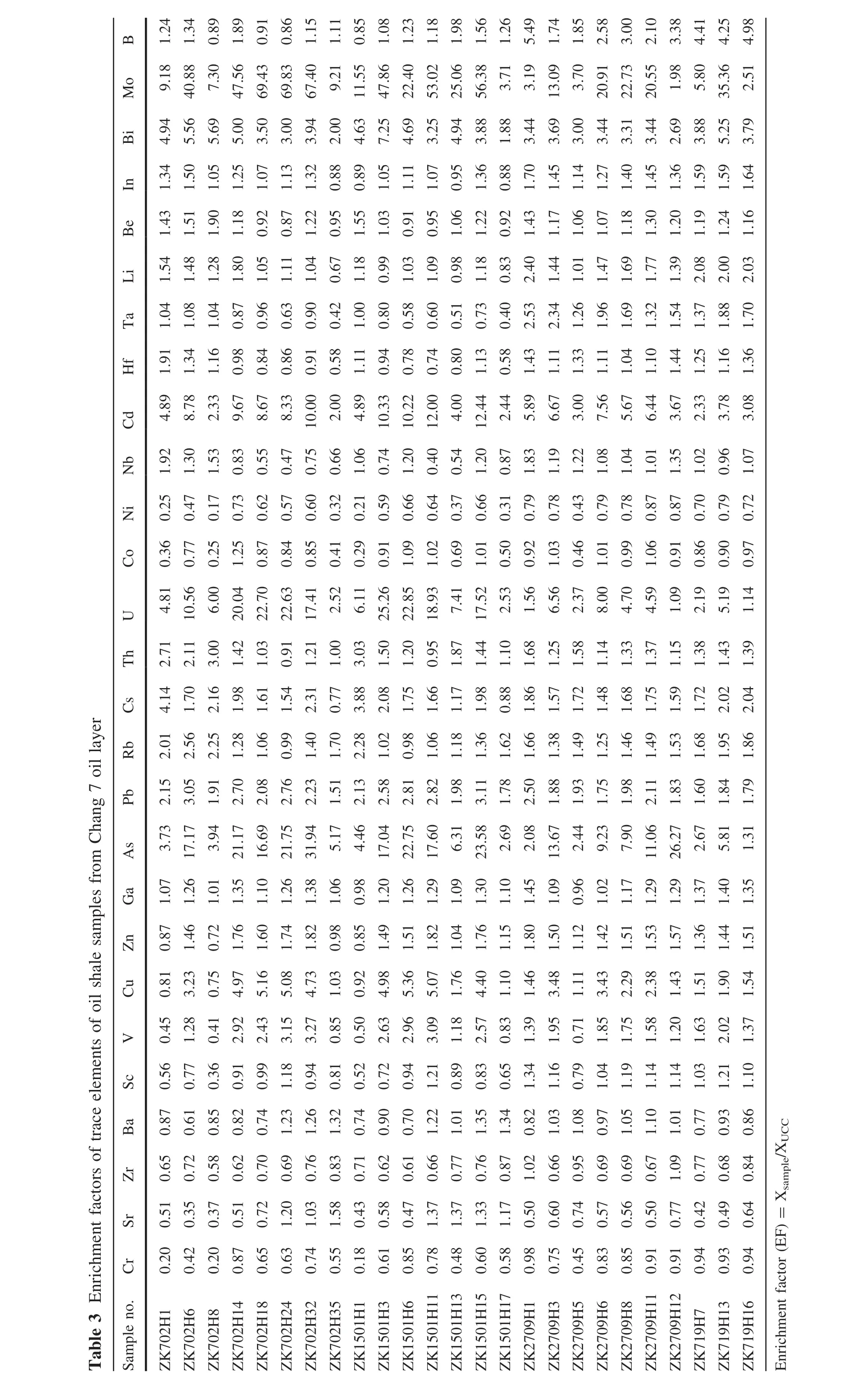
?
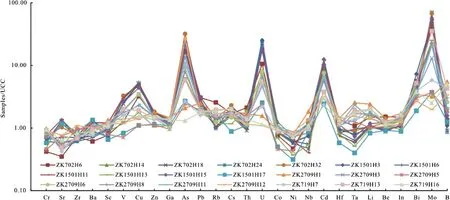
Fig.5 Spider diagram of trace elements of oil shale from Chang 7 oil layer
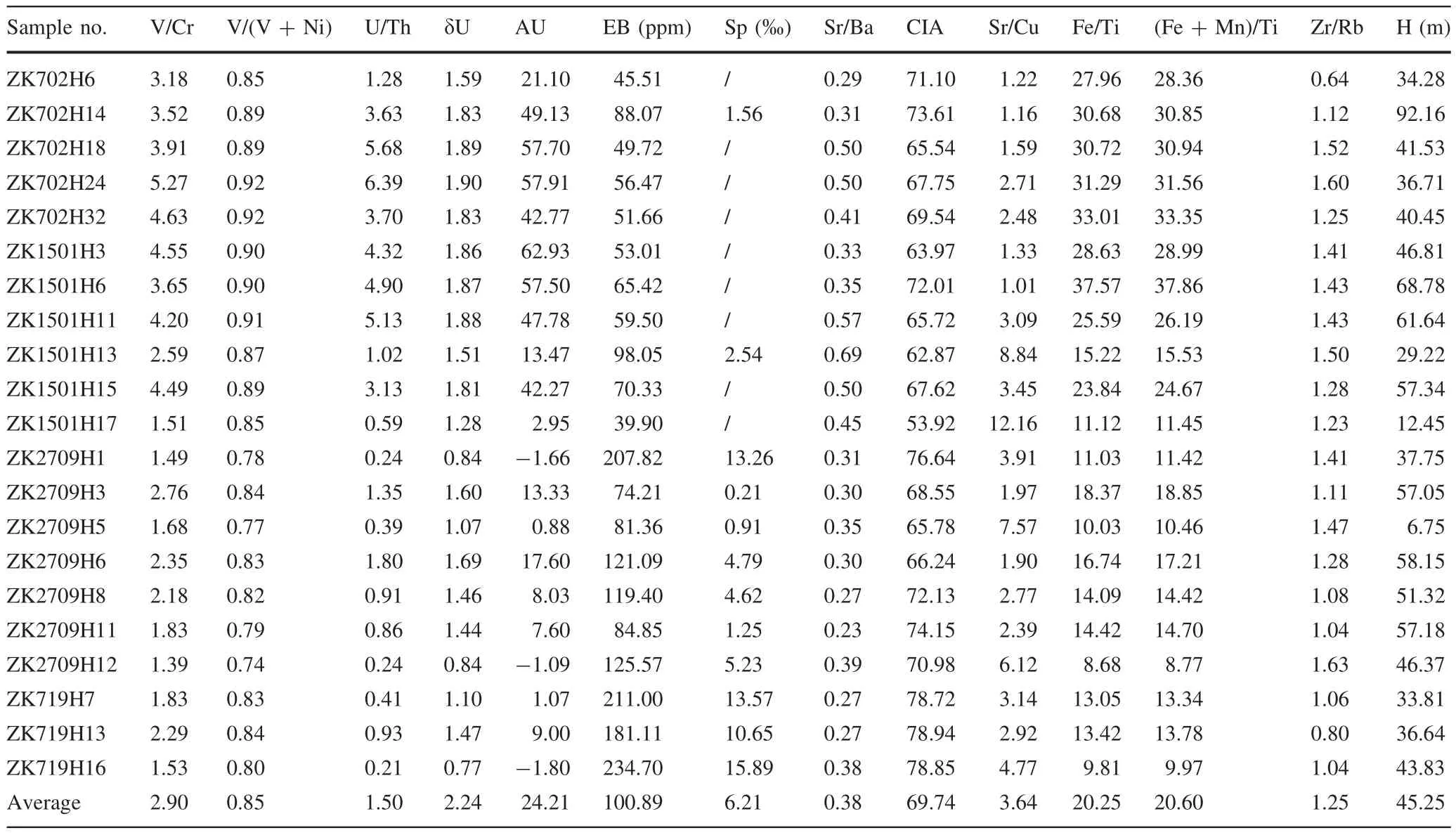
Table 4 Parameters of the palaeosedimentary environment of oil shale samples from Chang 7 oil layer
Occurring in zircon,element Zr is a typical continental inert element and deposits in shallow water sections.Due to its active chemical property,element Rb tends to migrate and deposit in deep water with high energy(Teng et al.2005).Therefore,Zr/Rb ratio can be applied to response the variation of depth of water.The smaller Zr/Rb ratio turns,the deeper sedimentary water is and the weaker hydrodynamic force is.Teng(2004)studied Zhuozishan Formation Profile of Lower Ordovician in Ordos Basin and found that the average of Zr/Rb is 0.92,reflecting weak hydrodynamic force.The Zr/Rb of oil shale samples from Upper Paleozoic Shanxi Formation in Ordos Basin ranges from 1.25 to 4.76(average 2.12),showing relatively strong paleo-hydrodynamics(Zhao et al.2016)(Table 5).The Zr/Rb ratio of oil shale samples is from 0.64 to 1.63 with an average of 1.25,showing a weak hydrodynamic force.
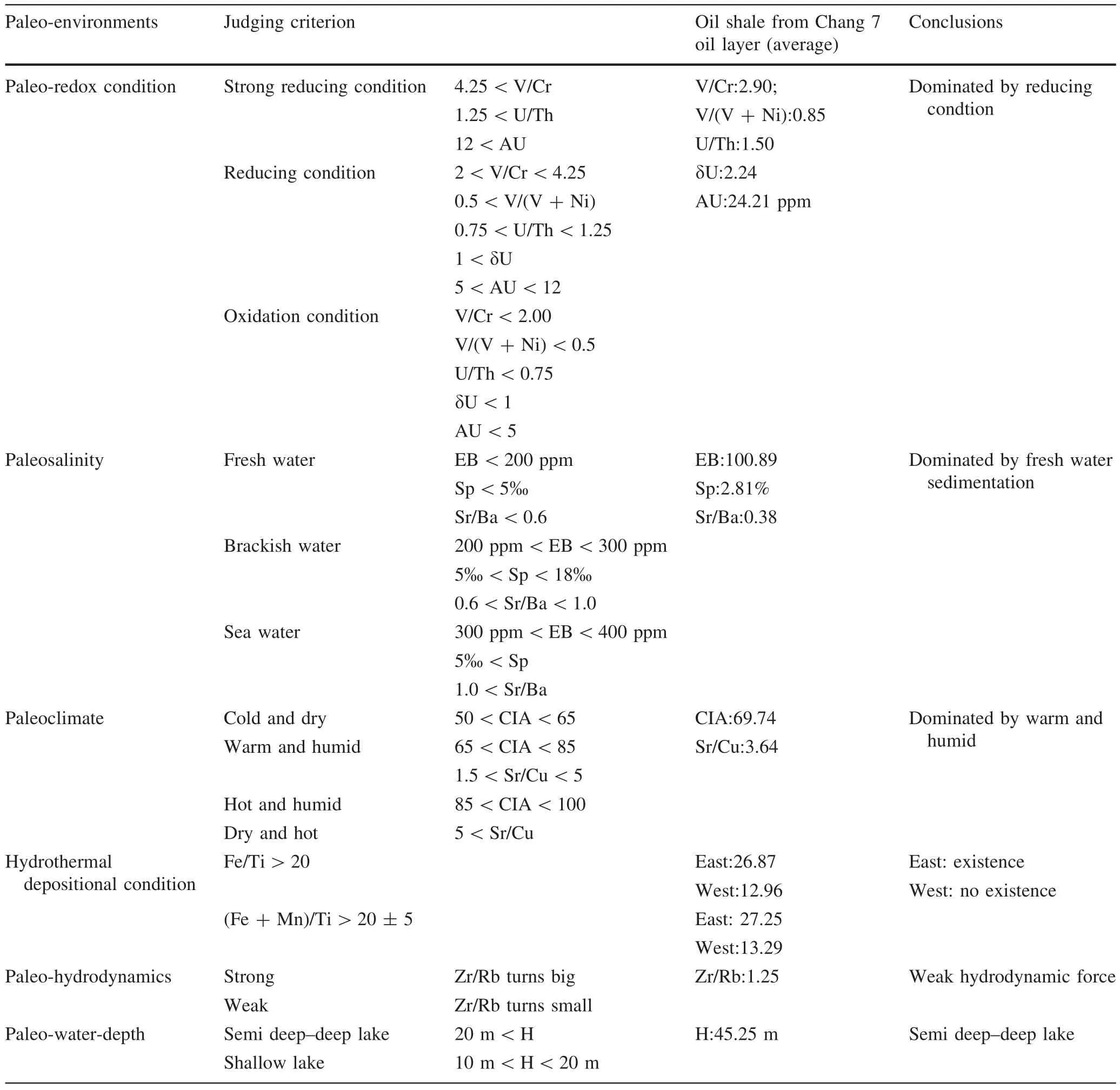
Table 5 Geochemical index of sedimentary environment and geochemical parameters of oil shale from Chang 7 oil layer
5.1.6 Paleo-water-depth
The content of element Co can be applied to calculate paleo-water-depth quantitatively(Wu and Zhou 2000).The calculation is H=3.05×105/[Vo×Nco/(Scot×Tco)]1.5(Wu and Zhou 2000).H:paleo-water-depth(m);Vo:deposition rate of sediments(m/Ma);Sco:Co abundance of samples;Nco:Co abundance of normal lacustrine sediments(20 ppm);Tco:Co abundance of provenance(4.68 ppm)t:contribution values of Co from provenance to samples[can be replaced by(La from samples)/(La from terrigenous detrital)ratio and La from terrigenous detrital is 38.99 ppm](Wu and Zhou 2000).The depositional rate of sediments of normal lake ranges from 150 to 300 m/Ma.Considering study location in the lake and previous researches(Zhang and Zhao 2002),we set Vo as 200 m/Ma.
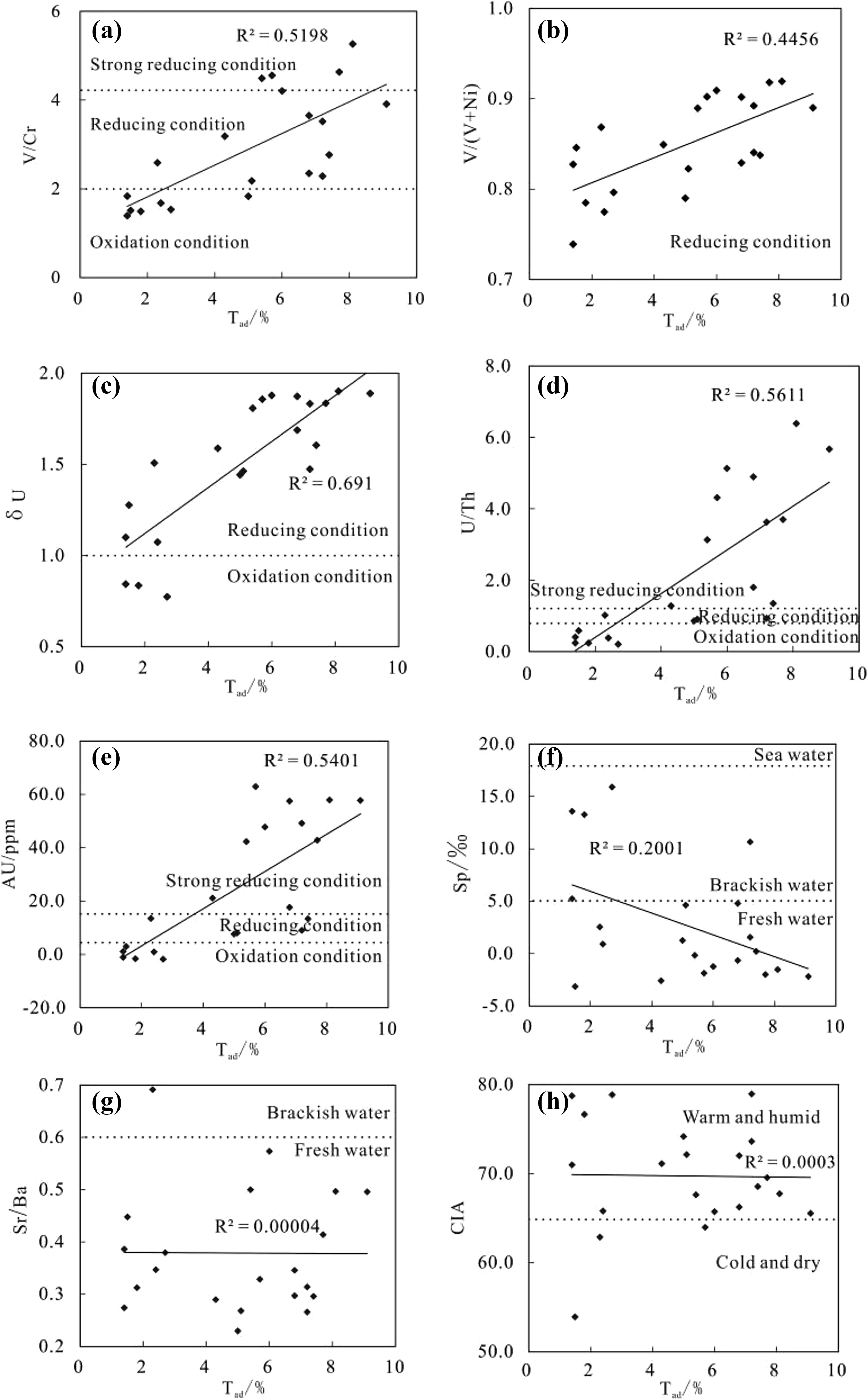
Fig.6 Correlations diagram of oil yield versus parameters of palaeosedimentary environment of oil shale from Chang 7 oil layer
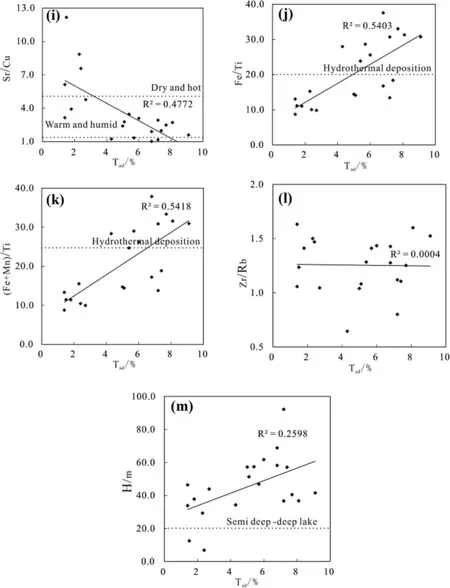
Fig.6 continued
The calculated results indicate that paleo-water-depth during sedimentation of oil shale samples is from 6.75 to 92.16(average 45.25)(Table 5).Usually,the depth above 20 meters is defined as semi deep–deep lake and the depth from 10 to 20 m is set as a shallow lake,so the oil shale samples from Chang 7 oil layer deposit in semi deep–deep lake(Table 5),which is in accordance with sedimentary facies.
5.2 Paleo-environment controlling factors on oil yield
Paleo-environment can influence oil yield of oil shale.However,there are so many factors to consider when referring to the sedimentary environment and the factors are interrelated.So,in order to discuss their controlling degree on oil yield of oil shale,here we separate the above six factors factitiously and suppose they are independent.Meanwhile,we assume all parameters can represent their corresponding sedimentary factors accurately.Then we focus on the individual factors to be discussed.
Different degree of correlation between oil yield and palaeoenvironment parameters can be seen from Fig.4.Five parameters(V/Cr,V/(V+Ni),U/Th,δU and AU)can all indicate that paleo-redox condition has an obvious influence on oil yield and high oil yield is closely related to the reducing condition(Fig.6a–e).For paleosalinity,the parameter Sp is more sensitive to oil yield than Sr/Ba andfresh water,compared with brackish water,is good for high oil yield(Fig.6f–g).Two parameters concerning paleoclimate all explain that warm and humid climate is of great benefit to oil yield(Fig.6h–i)and in Sr/Cu–Taddiagram(Fig.6i)it seems that the more humid the climate becomes,the bigger oil yield turns.For the judgment of hydrothermal deposition,the hydrothermal fluid has a positive influence on oil yield(Fig.6j–k).Paleo-hydrodynamics parameter shows a negligible relationship with oil yield,indicating the effect of paleo-hydrodynamics may be inconspicuous(Fig.6l).In addition,paleo-water-depth has certain control effect on oil yield of oil shale obviously(Fig.6m).

Table 6 Results of correlation analysis between oil yield and parameters of oil shale from Chang 7 oil layer

Table 7 Results of homogeneity test of variance model between oil yield and parameters of oil shale from Chang 7 oil layer
To further determine to influence degree of six factors on oil yield,Student’s t test here is used to make sure which factors do affect oil yield and which factors doesn’t.Then Homogeneity test of the variance in statistics is applied to decide which factors impact more and which factors impact less(Feng et al.2006).Statistically speaking,thePvalue is a declining indicator of confidence level,representing error probability of whole samples.If thePvalue is equal to 0.05,it means that 5%of samples is caused by contingency.So,samples are considered relevant whenPis below 0.05.Otherwise,samples are not relevant.Meanwhile,thatPvalue approaches to 0 indicates correlation is favorable(Feng et al.2006).
In 5,parameters of the paleo-redox condition,Pvalues of the parameters are all below 0.05,indicating that the parameters can well reflect changes of oil yield(Table 6)and the paleo-redox condition has a positive correlation with oil yield.Two parameters of paleosalinity all show low correlations(R2=0.00004;0.2001)with oil yield andPvalue are all below 0.05(P=0.978;0.42),which illustrates that effect of paleosalinity on oil yield can be ignored.Maybe due to different methods,CIA of paleoclimate shows low correlation and high P value with oil yield,whilePvalue of Sr/Cu is below 0.05.Therefore,it is for sure that there are impacts of paleoclimate on oil yield.Pvalues of two parameters in hydrothermal depositional condition are below 0.05,implying obvious influence on oil yield.Parameters of paleo-hydrodynamics conduct highPvalue(P=0.935)on oil yield.So,it is considered not to affect oil yield.ThePvalue of paleo-water-depth is 0.018,indicating that oil yield of oil shale is influenced by paleowater-depth.In summary,paleo-redox condition,paleoclimate, paleo-water-depth,and hydrothermal depositional condition affect oil yield of oil shale obviously,while the influences of paleosalinity and paleo-hydrodynamics are inconspicuous.
After analyzing single factors,relevant multi-factors are discussed to identify different effective proportion on oil yield by Homogeneity test of variance.In 4 factors,parameters having the highest R2are chosen to represent corresponding factors.For example,δU is selected to stand for the paleo-redox condition due to its highest R2value(0.691).Then,δU,Sr/Cu,(Fe+Mn)/Ti,and H are calculated to build correlation model with oil yield.ThePvalue of linear regression model is 0.000,illustrating that the model can well express oil yield.Pvalues of individual factors are shown in Table 7.As explained above,the smallerPvalue is,the bigger contribution degree is.Therefore,the paleo-redox condition represented by δU effect oil yield of oil shale most.Paleoclimate represented by Sr/Cu ranks second.The third and the fourth factors are a hydrothermal depositional condition,represented by(Fe+Mn)/Ti,and paleo-water-depth represented by H.
Through statistical analysis can provide a theoretical foundation,theory results still need to accord with geological regularity.Obvious relations have been seen from scatter diagram and correlation analysis,indicating that main controlling factors of oil yield in oil shale from Chang7 oil layer in Ordos Basin are a paleo-redox condition,paleoclimate,hydrothermal depositional condition,and paleo-water-depth.
However,the paleosalinity and paleo-hydrodynamics showing no obvious correlations with oil yield in numerically doesn’t mean they have no impact on oil yield.Actually,lacustrine oil shale usually deposits in fresh water and weak hydrodynamic condition(Fan et al.2012;Zhang et al.2004)so that oil shale can form favorably.Hence,more concentrative ranges in parameters of paleosalinity and paleo-hydrodynamics may be the primary reasons of low correlations.In future,cognition of main influencing factors must be gradually increasing along with the augment of analytical factors.
6 Conclusions
1. The palaosedimentary environments of oil shale from Chang 7 oil layer are mainly reducing condition,fresh water and brackish water,warm and humid weather,hydrothermal fluid condition,weak hydrodynamic force,and semi deep–deep lake.
2. The paleo-redox condition,together with paleoclimate, paleo-water-depth and hydrothermal depositional condition,affect oil yield of oil shale obviously,while the influences of paleosalinity and paleo-hydrodynamics are not the main controlling factors.
3. The paleo-redox condition affects oil yield of oil shale most and the conditions of paleoclimate,hydrothermal depositional,and paleo-water-depth are followed in order.
AcknowledgementsThis work was supported with funding from the National Natural Science Foundation of China(No.41173055)and the Fundamental Research Funds for the Central Universities(No.310827172101).
Adams TD,Haynes JR,Walker CT(1965)Boron in holocene illites of the dovey estuary,wales,and its relationship to palaeosalinity in cyclothems.Sedimentology 4(3):189–195
Bai Y,Liu Z,Sun P,Liu R,Hu X,Zhao H,Xu Y(2015)Rare earth and major element geochemistry of Eocene fine-grained sediments in oil shale-and coal-bearing layers of the Meihe Basin,Northeast China.J Asian Earth Sci 97(97):89–101
Boström K(1983)Genesis of ferromanganese deposits-diagnostic criteria for recent and old deposits.Hydrothermal Processes at Sea floor Spreading Centers,Springer,Berlin,pp 473–489
Brumsack HJ(1988)Rezente,Corg-reiche Sedimente als Schlüssel zum Verständnis fossiler Schwarzschiefer.Habilitation Thesis,University of Göttingen,Germany
Chang Y,Liu RH,Bai WH,Sun SS(2012)Geologic characteristic and regular pattern of Triassic oil shale in the south of Ordos Basin.China Pet Explor 17(2):74–78(in Chinese)
Chermak JA,Schreiber ME(2014)Mineralogy and trace element geochemistry of gas shales in the United States:environmental implications.Int J Coal Geol 126(3):32–44
Chu CL,Chen QL,Zhang B,Shi Z,Jiang HJ,Yang X(2016)Influence on formation of Yuertusi Source Rock by hydrothermal activities at Dongergou section,Tarim Basin.Acta Sedimentol Sin 34(4):803–810(in Chinese with English abstract)
Cox R,Lowe DR,Cullers RL(1995)The influence of sediment recycling and basement composition on evolution of mudrock chemistry in the southwestern United States.Geochim Cosmochim Acta 59(14):2919–2940
Dean WE,Arthur MA(1989)Iron–sulfur–carbon relationships in organic-carbon-rich sequences I:cretaceous Western Interior Seaway.Am J Sci 289:708–743
Degens ET,Williams EG,Keith ML(1958)Environmental studies of carboniferous sediments:part II.Application of geochemical criteria.Bull J Immunol 42:981–997
Deng HW,Qian K(1993)Sedimentary geochemistry and environmental analysis.Gansu Science And Technology Press,Gansu(in Chinese)
Ernst TW(1970)Geochemical facies analysis.Elsevier,Amsterdam
Fahmi R,Bridgwater T,Donnison I,Jones JM(2008)The effect of lignin and inorganic species in biomass on pyrolysis oil yields,quality and stability.Fuel 87(7):1230–1240
Fan YH,Qu HJ,Wang H,Yang XC,Feng YW(2012)The application of trace elements analysis to identifying sedimentary media environment:a case study of Late Triassic strata in the middle part of western Ordos Basin.Geol China 39(2):382–389
Feng JH,Che GM,Nie YF(2006)Numerical analysis principle.Science Press,Beijing(in Chinese)
Fu XG,Wang J,Zeng Y,Tan F,Chen W,Feng X(2010a)Geochemistry of rare earth elements in marine oil shale-a case study from the Bilong Co area,Northern Tibet,China.Oil Shal 27(3):194–208
Fu XG,Wang J,Zeng Y,Tan F,Feng X(2010b)REE geochemistry of marine oil shale from the Changshe Mountain area,northern Tibet,China.Int J Coal Geol 81(3):191–199
GB/T14506.1~14-2010(2010)Methods for chemical analysis of silicate rocks(in Chinese with English abstract)
GB/T14506.30-2010(2010)Methods for chemical analysis of silicate rocks-part 30:determination of 44 elements(in Chinese with English abstract)
Han X,Kulaots I,Jiang X,Suuberg EM(2014)Review of oil shale semicoke and its combustion utilization.Fuel 126(12):143–161
He ZX(2003)Evolution and oil–gas of the Ordos Basin.Petroleum Industry Press,Beijing(in Chinese)
Jiang CF,Wang XZ,Zhang LX,Wan YP,Lei YH,Sun JB,Guo C(2013)Geological characteristics of shale and exploration potential of continental shale gas in 7th member of Yanchang Formation,southeast Ordos Basin.Geol China 40(6):1880–1888(in Chinese with English abstract)
Jones B,Manning DAC(1994)Comparison of geochemical indices used for the interpretation of depositional environments in ancient mudstones.Chem Geol 111(1–4):112–129
Keith ML,Bystrom AM(1959)Comparative analyses of marine and fresh-water shales.Pa State Univ Min Ind Exp Stn Bull
Lendergren S,Carvajal MC(1969)Geochemistry of boron.III.The relationship between boron concentration in marine clay sediments and the salinity of the depositional environments expressed as an adsorption isotherm.Arkiv Mineral Geol 5:13–22
Li X,Chen Q,Liu H,Wan YR,Wei LH,Liao JB,Long LW(2011)Features of sandy debris flows of the Yanchang formation in the Ordos Basin and its oil and gas exploration significance.Acta Geol Sin 85(5):1187–1202
Li R,Liu H,Zhu R,Deng X,Li Y,Guo Z(2013)Anomalous pressure driving oil migration:evidence from multiphase boiling hydrocarbon fluid inclusions in Yanchang Reservoir,Ordos Basin.Sci Geol Sin 48(4):1219–1233(in Chinese with English abstract)
Li YH,Jiang T,Wu FL,Zhang HY,Yao ZG,Wang BW(2014)Evaluation methods and results of oil shale resources in southeastern Ordos Basin.Geol Bull China 33(9):1417–1424
Liang WJ,Xiao CT,Xiao K,Lin W(2015)The relationship of Late Jurassic paleoenvironment and paleoclimate with geochemical elements in Amdo Country of northern Tibet.Geol China 42(4):1079–1091(in Chinese with English abstract)
Liu ZJ,Yang LH,Dong QS,Zhu JW,Guo W,Ye SQ,Liu R,Meng QT,Zhang HL,Gan SC(2009)Oil shale in China.Petroleum Industry Press,Beijing(in Chinese with English abstract)
Liu R,Liu ZJ,Guo W,Chen HJ(2015)Characteristics and comprehensive utilization potential of oil shale of the Yin’e Basin,Inner Mongolia,China.Oil Shale 32(4):293–312
Ma ZH,Chen QS,Shi ZW,Wang C,Du WG,Zhao CY(2016)Geochemistry of oil shale from Chang 7 reservoir of Yanchang Formation in south Ordos Basin and its geological significance.Geol Bull China 35(9):1550–1558(in Chinese with English abstract)
Mapoma HWT,Xie X,Zhang L(2014)Redox control on trace element geochemistry and provenance of groundwater in fractured basement of Blantyre,Malawi.J AfrEarth Sci 100:335–345
Mukhopadhyay PK,Goodarzi F,Crandlemire AL,Gillis KS,Macneil DJ,Smith WD(1998)Comparison of coal composition and elemental distribution in selected seams of the Sydney and Stellarton Basins,Nova Scotia,Eastern Canada.Int J Coal Geol 37(1–2):113–141
Nesbitt HW,Young GM(1982)Early proterozoic climates and plate motions inferred from major element chemistry of lutites.Nature 299(5885):715–717
Patterson JH,Ramsden AR,Dale LS,Fardy JJ(1986)Geochemistry and mineralogical residences of trace elements in oil shales from Julia Creek,Queensland,Australia.Chem Geol 55:1–16
Qin JZ(2005)The hydrocarbon source rock in China.Science Press,Beijing(in Chinese)
Qiu X,Liu C,Mao G,Deng Y,Wang F,Wang J(2014)Late Triassic tuff intervals in the Ordos basin,Central China:their depositional,petrographic,geochemical characteristics and regional implications.J Asian Earth Sci 80:148–160
Qiu XW,Liu CY,Wang FF,Deng Y,Mao GZ(2015)Trace and rare earth element geochemistry of the Upper Triassic mudstones in the southern Ordos Basin,Central China.Geol J 50(4):399–413
Rudnick RL,Gao S(2003)Composition of the continental crust.Treatise Geochem 3:1–64
SH/T 0508-1992(1992)The test method for oil yield from oil shale—the method of low temperature carbonization(in Chinese with English abstract)
Sun ZC,Yang P,Zhang ZH(1997)Seolmentirry enuironments and hydrocarbon generation of Cenoaoic Salified Lakes in China.Petroleum Industry Press,Beijing(in Chinese)
Sun SS,Yao YB,Lin W(2015)Elemental geochemical characteristics of the oil shale and the Paleo-Lake environment of the Tongchuan Area,Southern Ordos Basin.Bul Mineral Petrol Geochem 34(3):642–645(in Chinese with English abstract)
Teng GE(2004)The Distribution of elements,carbon and oxygen isotopes on Marine Strata and environmental correlation between they and hydrocarbon source rocks formation—an example from Ordovician Basin,China.Graduate School of Chinese Academy of Sciences(Lanzhou Institute of Geology),Lanzhou
Teng GE,Liu WH,Xu YC,Chen JF(2004)Identification of effective source rocks of Ordovician marine sediments in Ordos Basin.Prog Nat Sci 14(11):1249–1252(in Chinese)
Teng GE,Hui LW,Xu YC,Chen JF(2005)Correlative study on parameters of inorganic geochemistry and hydrocarbon source rocks formative environment.Adv Earth Sci 20(2):193–200
Tribovillard N,Algeo TJ,Lyons T,Riboulleau A(2006)Trace metals as paleoredox and paleoproductivity proxies—an update.Chem Geol 232(1–2):12–32
Walker CT(1963)Departure curves for computing paleosalinity from boron in illities and shales.AAPG Bull 47(5):833–841
Wan YS,Xie HQ,Yang H,Wang AJ,Liu DY,Kröner A,Wilde SA,Geng YS,Sun LY,Ma MZ,Liu SJ,Dong CY,Du LL(2013)Is the Ordos block Archean or Paleoproterozoic in age?Implications for the Precambrian evolution of the North China craton.Am J Sci 313:683–711
Wang YY,Wu P(1983)Geochemical criteria of sediments in the coastal area of Jiangsu and Zhejiang Provinces.J Tongji Univ(Nat Sci)4:82–90(in Chinese with English abstract)
Wang JQ,Liu CY,Yan JP,Zhao HG,Gao F,Liu C(2010)Development time and evolution characteristics of Weibei uplift in the south of Ordos Basin.J Lanzhou Univ(Nat Sci)46(4):22–29(in Chinese with English abstract)
Wu ZP,Zhou YQ(2000)Using the characteristic elements from meteoritic must in strata to calculate sedimentation rate.Acta Sedimentol Sin 18(3):395–399 (in Chinese with English abstract)
Xiao RG,Takao O,Cai K,Yoshikazu K(1999)Application of boron and boron isotopic geochemistry in the study of geological process.Earth Sci Front(China University of Geosciences,Beijing)6(2):361–368(in Chinese with English abstract)
Yang H,Niu XB,Xu LM,Feng SB,You Y,Liang XW,Wang F,Zhang DD(2016)Exploration potential of shale oil in Chang 7 member,upper triassic Yanchang formation,Ordos Basin,NW China.Pet Explor Dev 43(4):511–520
Yuan XJ,Lin SH,Liu Q,Yao JL,Wang L,Guo H,Deng XQ,Cheng DW(2015)Lacustrine fine-grained sedimentary features and organic rich shale distribution pattern:a case study of Chang 7 member of triassic Yanchang formation in Ordos Basin,NW China.Pet Explor Dev 42(1):37–47(in Chinese with English abstract)
Zhang XH,Zhao ZY(2002)Definition of Milankovitch cycles for Yangchang formation of the upper triassic in Ordos Basin.Oil Gas Geol 23(4):372–375(in Chinese with English abstract)
Zhang JF,Fan YF,Zhang JJ,Wang GC(2004)Microelement and geologic significance of Yanchang formation in Fuxian area,Ordos Basin.Xinjiang Pet Geol 25(5):483–485(in Chinese with English abstract)
Zhang CL,Gao AL,Liu Z,Huang J,Yang YJ,Zhang Y(2011)Study of character on sedimentary water and Palaeoclimate for Chang 7 oil layer in Ordos Basin.Nat Gas Geosci 22(4):582–587(in Chinese with English abstract)
Zhao LY,Chen JN,Wang TS(1991)Grade dividing and composition of oil shale in China.Geoscience 5(4):423–429(in Chinese with English abstract)
Zhao BS,Li RX,Wang XZ,Wu XY,Wang N,Qin XL,Cheng JH,Li JJ(2016)Sedimentary environment and preservation conditions of organic matter analysis of Shanxi formation mud shale in Yanchang exporation area,Ordos Basin.Geol Sci Technol Inf 35(6):103–111(in Chinese with English abstract)
Zheng Q,Liu Q,Shi S(2016)Mineralogy and geochemistry of ammonian illite in intra-seam partings in Permo-Carboniferous coal of the Qinshui coal field,North China.Int J Coal Geol 153:1–11
Zhong DK,Jiang ZK,Guo Q,Sun HT(2015)A review about research history,situation and prospects of hydrothermal sedimentation.J Palaeogeogr17(3):285–296 (in Chinesewith English abstract)
杂志排行
Acta Geochimica的其它文章
- Limestone mechanical deformation behavior and failure mechanisms:a review
- Thermodynamic properties of San Carlos olivine at high temperature and high pressure
- Geochemistry and petrology of rift-related mafic sills and arc-related Gabbro–Diorite bodies,Northern Bafq District,Central Iran
- A study of groundwater irrigation water quality in south-central Bangladesh:a geo-statistical model approach using GIS and multivariate statistics
- Influence on lacustrine source rock by hydrothermal fluid:a case study of the Chang 7 oil shale,southern Ordos Basin
- Determination of Hf–Sr–Nd isotopic ratios by MC-ICP-MS using rapid acid digestion after flux-free fusion in geological materials
